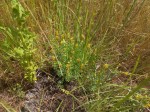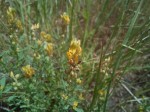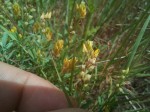Crotalaria parvula
Selected images: Click on each image to see a larger version and details of the record View all images (3)
Detailed records: Display species records QDS maps by: Google Maps Point records by Google Maps
Species details: Click on each item to see an explanation of that item (Note: opens a new window)
| Synonyms: | |
| Common names: | |
| Frequency: | |
| Status: | |
| Description: |
Annual, with slender erect stem, 5–40 cm tall, developing numerous ascending or spreading stems from the base, often also short flowering branches at the top; stem rather densely appressed puberulous. Leaves 3-foliolate; leaflets 5–12 × 1.5–4 mm, linear-oblanceolate to oblanceolate, rounded to truncate or retuse, appressed puberulous beneath; petiole 2–5 mm long; stipules 0. Racemes or heads sessile, dense, 1–3(6 in fruit) cm long, many-flowered; bracts 1–1.5 mm long, linear; pedicel 1–2 mm long, sometimes with minute bracteoles. Calyx 2–3 mm long, ± densely appressed puberulous; upper lobes narrowly attenuate-triangular, 2–3 times as long as the tube. Standard oblong-obovate, pale yellow, reddish marked basally inside, red lined outside and medially puberulous to tomentellous, glabrous near the edges; wings shorter than the keel; keel 3–4 mm long, angular, with a narrow twisted beak. Pod sessile, 2–3.5 mm long, ovoid-globose, puberulous, 2-seeded. Seeds 1–1.5 mm long, ovate-cordiform, smooth, with a prominent aril. |
| Type location: |
Angola |
| Notes: | |
| Derivation of specific name: | parvula: Latin for very small |
| Habitat: | |
| Altitude range: (metres) | |
| Flowering time: | Mar - Apr(-May) |
| Worldwide distribution: | Nigeria, Cameroon, Central African Republic, Angola, DRC, Burundi, Malawi, Zambia and Tanzania |
| Growth form(s): | Annual. |
| Endemic status: | |
| Red data list status: | |
| Insects associated with this species: | |
| Spot characters: | Display spot characters for this species |
| Literature: |
Martins, E.S. et al. (2003). Papilionoideae Flora Zambesiaca 3(7) Pages 223 - 224. Ntore, S. & al. (2024). Checklist of the vascular plants of Burundi Page 119. |
Other sources of information about Crotalaria parvula:
Our websites:
Flora of Malawi: Crotalaria parvulaFlora of Zambia: Crotalaria parvula
External websites:
African Plants: A Photo Guide (Senckenberg): Crotalaria parvulaAfrican Plant Database: Crotalaria parvula
BHL (Biodiversity Heritage Library): Crotalaria parvula
EOL (Encyclopedia of Life): Crotalaria parvula
GBIF (Global Biodiversity Information Facility): Crotalaria parvula
Google: Web - Images - Scholar
iNaturalist: Crotalaria parvula
IPNI (International Plant Names Index): Crotalaria parvula
JSTOR Plant Science: Crotalaria parvula
Mansfeld World Database of Agricultural and Horticultural Crops: Crotalaria parvula
Plants of the World Online: Crotalaria parvula
Tropicos: Crotalaria parvula
Wikipedia: Crotalaria parvula


